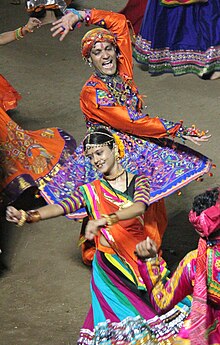Garbais a form of Gujaratidancewhich originates from the state ofGujarat,India. The name is derived from theSanskrittermGarbha.[1]Many traditional garbas are performed around a centrally lit lamp or apictureor statue of theHindugoddessDurga.Traditionally, it is performed during the nine-day HindufestivalNavaratri). Either the lamp (theGarba Deep) or an image of the Goddess,Durga(also calledAmba) is placed in the middle of concentric rings as an object of veneration.
 | |
| Instrument(s) | Singing and Sitar as well as Dhol |
|---|---|
| Origin | Gujarat,India |
| Garba of Gujarat | |
|---|---|
| Country | India |
| Reference | 01962 |
| Region | Asia and the Pacific |
| Inscription history | |
| Inscription | 2023 (18th session) |
| List | Representative |
Etymology
editThe wordgarbacomes from theSanskritword for womb and so implies gestation or pregnancy — life. Traditionally, the dance is performed around a clay lantern with a light inside, called aGarbha Deep( "womb lamp" ). This lantern represents life, and the fetus in the womb in particular. The dancers thus honorDurga,the feminine form of divinity.
Garba is performed in a circle as a symbol of theHinduview of time. The rings of dancers revolve in cycles, as time inHinduis cyclical. As the cycle of time revolve, from birth, to life, to death and again to rebirth, the only thing that is constant is the Goddess, that one unmoving symbol in the midst of all of this unending and infinite movement. The dance symbolizes that God, represented in feminine form in this case, is the only thing that remains unchanging in a constantly changing universe (jagat).
TheGarbha Deephas another symbolic interpretation. The vessel itself is a symbol of the body, within whom Divinity (in the form of the Goddess) resides. Garba is danced around this symbol to honour the fact that all humans have the Divine energy ofDeviwithin them.
Dance
edit-
Garba dressing: traditional dressing male iskediyuwhile the traditional female dress ischaniya choli.
-
Little girl dressed inGagra choli.
Modern Garba is also heavily influenced byDandiya Raas(Gujarātī:ડાંડીયા રાસ), a dance traditionally performed by men. The merger of these two dances has formed the high-energy dance that is seen today.[2]
Both men and women usually wear colorful clothes while performing garba anddandiya.The girls and the women wearChaniya choli,a three-piece dress with acholi,which is an embroidered and colorful blouse, teamed withchaniya,which is the flared, skirt-like bottom, with intricate work anddupatta,which is usually worn in the traditional Gujarati manner. Chaniya Cholis are decorated with beads, shells, mirrors, stars, embroidery work, mati, etc. Traditionally, women adorn themselves with jhumkas (large earrings), necklaces,bindi,bajubandh, chudas and kangans, kamarbandh, payal, and mojiris. Boys and men wear kafni pyjamas with aGhagra- a short roundkurta- above the knees and pagadi on the head with bandhini dupatta, kada, and mojiris. In Gujarati, these clothes worn by men is called'Kediyu'.Over the years, the interest in Garba has only increased. There is a huge interest in Garba among the youth of India and in particular, the Gujarati diaspora. Traditionally, this dance is performed in concentric circles and the entire group performs once step in sync, with the beat starting slow and slowly catching on speed.
Garba and Dandiya Raas are also popular in the United States where more than 20 universities have Raas/Garba competitions on a huge scale every year with professional choreography. The Canadian city ofTorontonow hosts North America's largest annual garba by number of attendees.[3]Garba is also very popular in the United Kingdom where there are a number of Gujarati communities who hold their own Garba nights and widely popular among the Gujarati community worldwide.
Tradition
editGarba is aGujarati folk dancecelebrated inNavratri,a celebration lasting nine nights. Garba songs typically revolve around the subjects of the nine goddesses. Garba styles vary from place to place in Gujarat.
The traditional clothing of the Garba dancer is red, pink, yellow, orange, and brightly colored chanya,choliorghagra choli;dupattawithbandhani(tie-dye),abhla(big mirrors) or with thick Gujarati borders. They also wear heavy jewellery, such as 2–3 necklaces, sparkling bangles, waist belts, and long oxidized earrings. Traditionally men wear an ethnickediaand a pajama or a dhoti with an oxidized bracelet and necklace. Normally, the dandiya sticks are Wooden.
Recognitions
editIn December 2023,UNESCOrecognisedGarbawith theIntangible cultural heritagetag.[4][5]
References
edit- ^Desai, Anjali (2007).India Guide Gujarat.India Guide Publications. p. 43.ISBN9780978951702.
- ^Sinha, Aakriti (2006).Let's Know Dances Of India.Star Publications. p. 26.ISBN9788176500975.Archivedfrom the original on 2023-10-22.Retrieved2021-10-06.
- ^"North America's Largest Raas-Garba".Toronto Garba.Archivedfrom the original on 2022-08-03.Retrieved2022-10-08.
- ^unesco declares gujarats garba as intangible cultural heritage
- ^"A Joyous Swirl: UNESCO Tags Gujarat's Garba An Intangible Cultural Heritage".Forbes India.Retrieved2024-10-11.